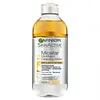What's inside
What's inside
 Key Ingredients
Key Ingredients

 Benefits
Benefits

 Concerns
Concerns

 Ingredients Side-by-side
Ingredients Side-by-side

Water
Skin ConditioningCyclopentasiloxane
EmollientIsohexadecane
EmollientArgania Spinosa Kernel Oil
EmollientBenzyl Alcohol
PerfumingBenzyl Salicylate
PerfumingButyl Methoxydibenzoylmethane
UV AbsorberCI 60725
Cosmetic ColorantDecyl Glucoside
CleansingDipotassium Phosphate
BufferingDisodium EDTA
Ethylhexyl Methoxycinnamate
UV AbsorberEthylhexyl Salicylate
UV AbsorberGeraniol
PerfumingHaematococcus Pluvialis Extract
AntioxidantHexylene Glycol
EmulsifyingLimonene
PerfumingLinalool
PerfumingPentaerythrityl Tetra-Di-T-Butyl Hydroxyhydrocinnamate
AntioxidantPolyaminopropyl Biguanide
PreservativePotassium Phosphate
BufferingSodium Chloride
MaskingParfum
MaskingWater, Cyclopentasiloxane, Isohexadecane, Argania Spinosa Kernel Oil, Benzyl Alcohol, Benzyl Salicylate, Butyl Methoxydibenzoylmethane, CI 60725, Decyl Glucoside, Dipotassium Phosphate, Disodium EDTA, Ethylhexyl Methoxycinnamate, Ethylhexyl Salicylate, Geraniol, Haematococcus Pluvialis Extract, Hexylene Glycol, Limonene, Linalool, Pentaerythrityl Tetra-Di-T-Butyl Hydroxyhydrocinnamate, Polyaminopropyl Biguanide, Potassium Phosphate, Sodium Chloride, Parfum
Water
Skin ConditioningPEG-6 Caprylic/Capric Glycerides
EmulsifyingPEG/PPG-8/3 Laurate
EmulsifyingButylene Glycol
HumectantNiacinamide
SmoothingHydroxyethyl Acrylate/Sodium Acryloyldimethyl Taurate Copolymer
Emulsion StabilisingPhenoxyethanol
PreservativeIsohexadecane
EmollientStyrene/Acrylates Copolymer
Chlorphenesin
AntimicrobialPolysorbate 60
EmulsifyingGlycerin
HumectantDisodium EDTA
Chamomilla Recutita Flower Water
MaskingParfum
MaskingHexylene Glycol
EmulsifyingCapryloyl Glycine
CleansingPEG-40 Hydrogenated Castor Oil
EmulsifyingTrideceth-9
EmulsifyingNonfat Dry Milk
Skin ConditioningCitric Acid
BufferingXylitylglucoside
Humectant1,2-Hexanediol
Skin ConditioningOryza Sativa Germ Oil
EmollientCaprylyl Glycol
EmollientOryza Sativa Bran Extract
Skin ConditioningDecylene Glycol
Skin ConditioningBisabolol
MaskingWater, PEG-6 Caprylic/Capric Glycerides, PEG/PPG-8/3 Laurate, Butylene Glycol, Niacinamide, Hydroxyethyl Acrylate/Sodium Acryloyldimethyl Taurate Copolymer, Phenoxyethanol, Isohexadecane, Styrene/Acrylates Copolymer, Chlorphenesin, Polysorbate 60, Glycerin, Disodium EDTA, Chamomilla Recutita Flower Water, Parfum, Hexylene Glycol, Capryloyl Glycine, PEG-40 Hydrogenated Castor Oil, Trideceth-9, Nonfat Dry Milk, Citric Acid, Xylitylglucoside, 1,2-Hexanediol, Oryza Sativa Germ Oil, Caprylyl Glycol, Oryza Sativa Bran Extract, Decylene Glycol, Bisabolol
 Reviews
Reviews

Ingredients Explained
These ingredients are found in both products.
Ingredients higher up in an ingredient list are typically present in a larger amount.
Disodium EDTA plays a role in making products more stable by aiding other preservatives.
It is a chelating agent, meaning it neutralizes metal ions that may be found in a product.
Disodium EDTA is a salt of edetic acid and is found to be safe in cosmetic ingredients.
Learn more about Disodium EDTAHexylene Glycol is a surfactant. Glycols are a class of alcohols. Hexylene Glycol is a surfactant and emulsifier.
As a surfactant, Hexylene Glycol helps gather dirt and oil on your skin to be washed away.
As an emulsifier, Hexylene Glycol helps keep water and oil together. This prevents them from separating in a product. Hexylene Glycol also thins out the texture of a product by lessening viscosity.
Hexylene Glycol has a small molecular weight.
Learn more about Hexylene GlycolIsohexadecane is added to enhance texture, emulsify, and to help cleanse. It is an isoparrafin. It is a component of petrolatum.
Due to its large size, Isohexadecane is not absorbed by the skin. Instead, it sits on top and acts as an emollient. Emollients help keep your skin soft and smooth by trapping moisture within.
Isohexadecane is often used in products designed to help oily skin. It is lightweight and non-greasy while helping to moisturize. When mixed with silicones, it gives a product a silky feel.
Learn more about IsohexadecaneParfum is a catch-all term for an ingredient or more that is used to give a scent to products.
Also called "fragrance", this ingredient can be a blend of hundreds of chemicals or plant oils. This means every product with "fragrance" or "parfum" in the ingredients list is a different mixture.
For instance, Habanolide is a proprietary trade name for a specific aroma chemical. When used as a fragrance ingredient in cosmetics, most aroma chemicals fall under the broad labeling category of “FRAGRANCE” or “PARFUM” according to EU and US regulations.
The term 'parfum' or 'fragrance' is not regulated in many countries. In many cases, it is up to the brand to define this term.
For instance, many brands choose to label themselves as "fragrance-free" because they are not using synthetic fragrances. However, their products may still contain ingredients such as essential oils that are considered a fragrance by INCI standards.
One example is Calendula flower extract. Calendula is an essential oil that still imparts a scent or 'fragrance'.
Depending on the blend, the ingredients in the mixture can cause allergies and sensitivities on the skin. Some ingredients that are known EU allergens include linalool and citronellol.
Parfum can also be used to mask or cover an unpleasant scent.
The bottom line is: not all fragrances/parfum/ingredients are created equally. If you are worried about fragrances, we recommend taking a closer look at an ingredient. And of course, we always recommend speaking with a professional.
Learn more about ParfumWater. It's the most common cosmetic ingredient of all. You'll usually see it at the top of ingredient lists, meaning that it makes up the largest part of the product.
So why is it so popular? Water most often acts as a solvent - this means that it helps dissolve other ingredients into the formulation.
You'll also recognize water as that liquid we all need to stay alive. If you see this, drink a glass of water. Stay hydrated!
Learn more about Water